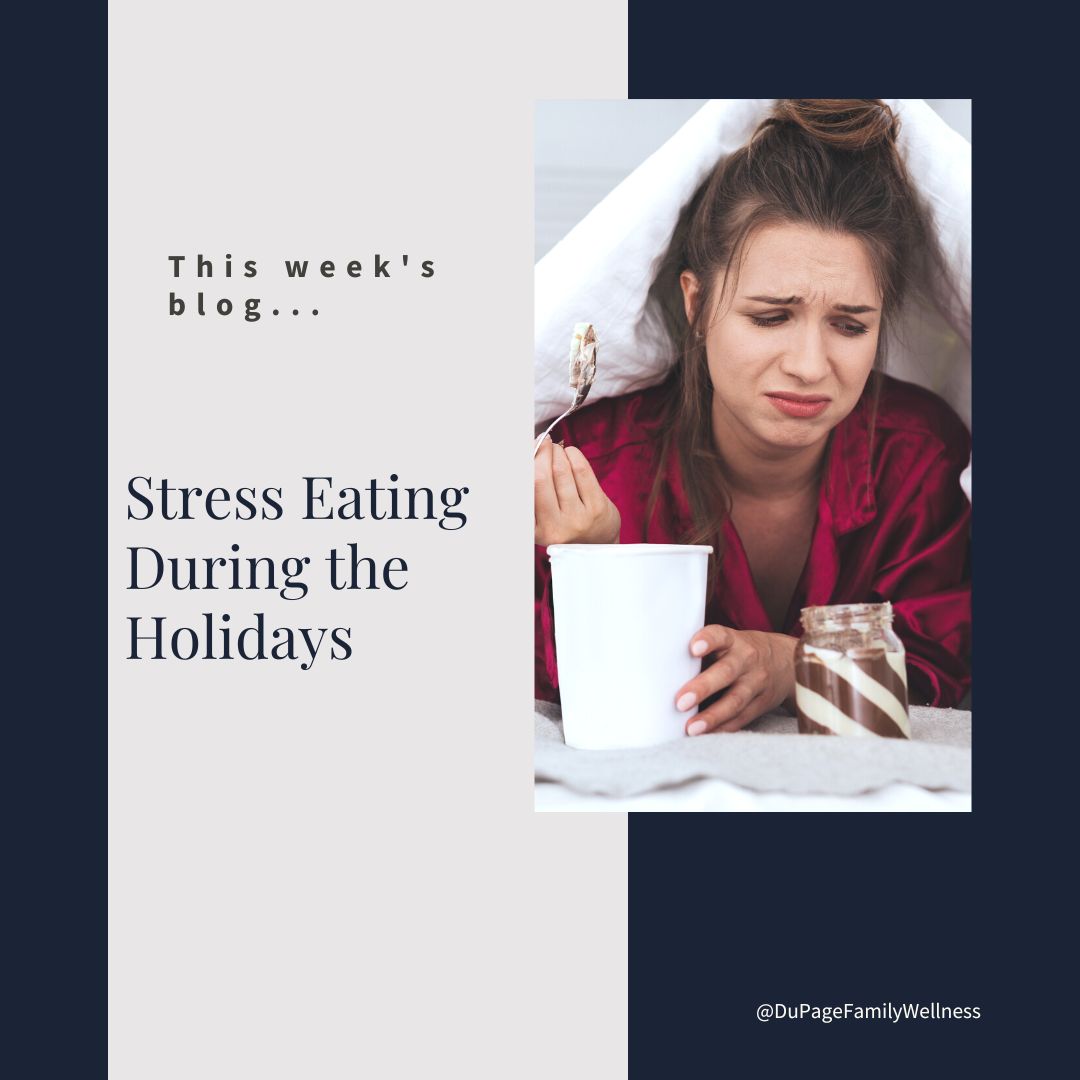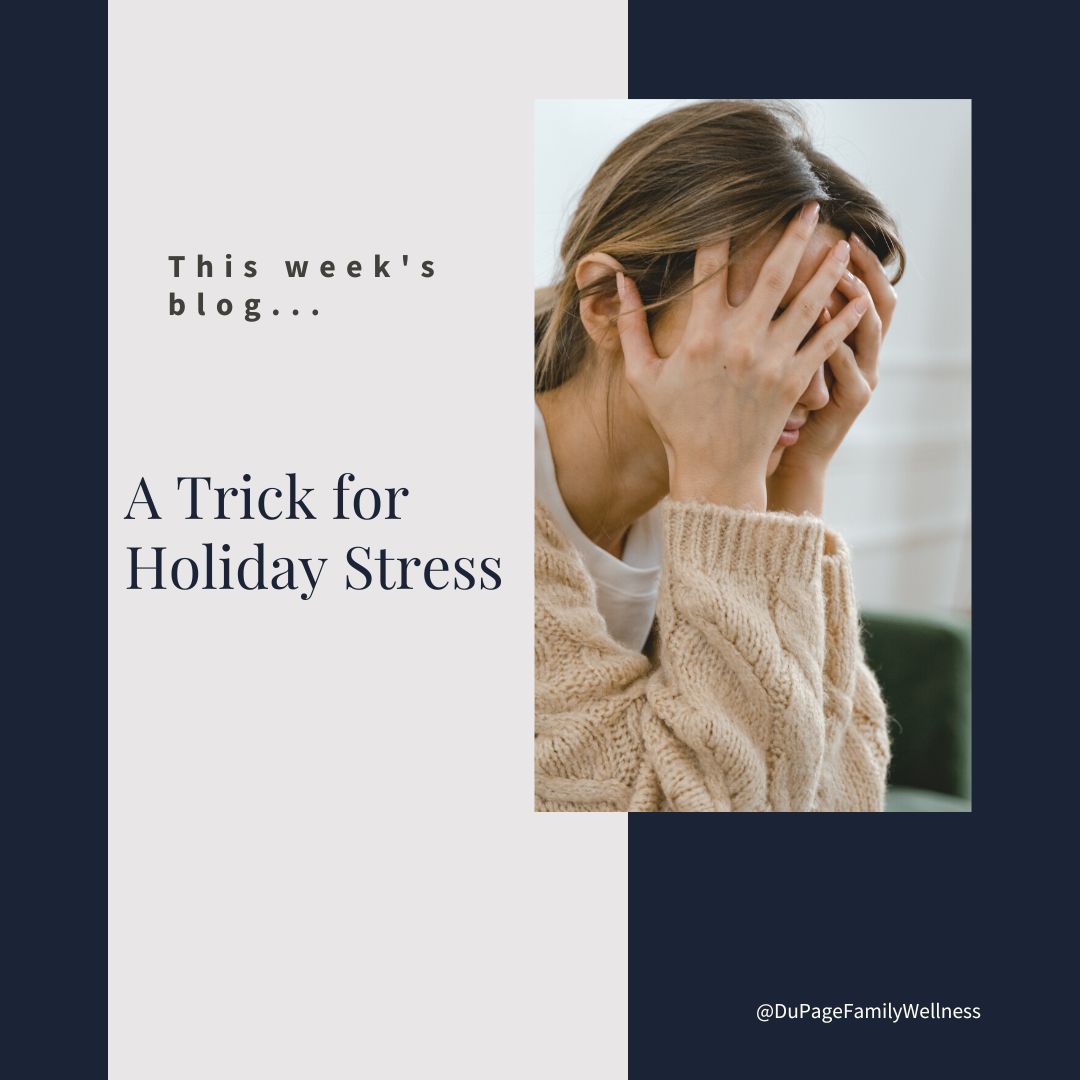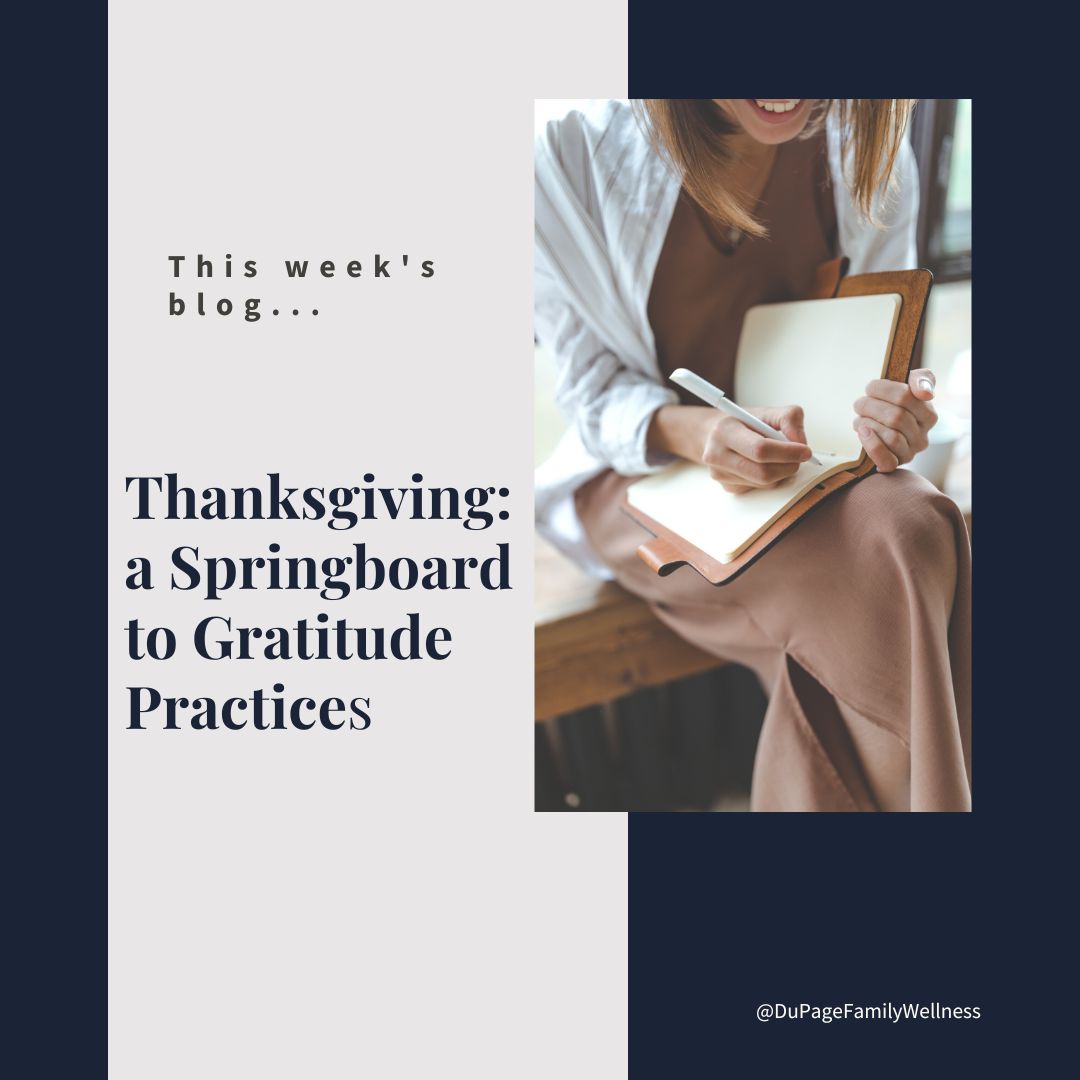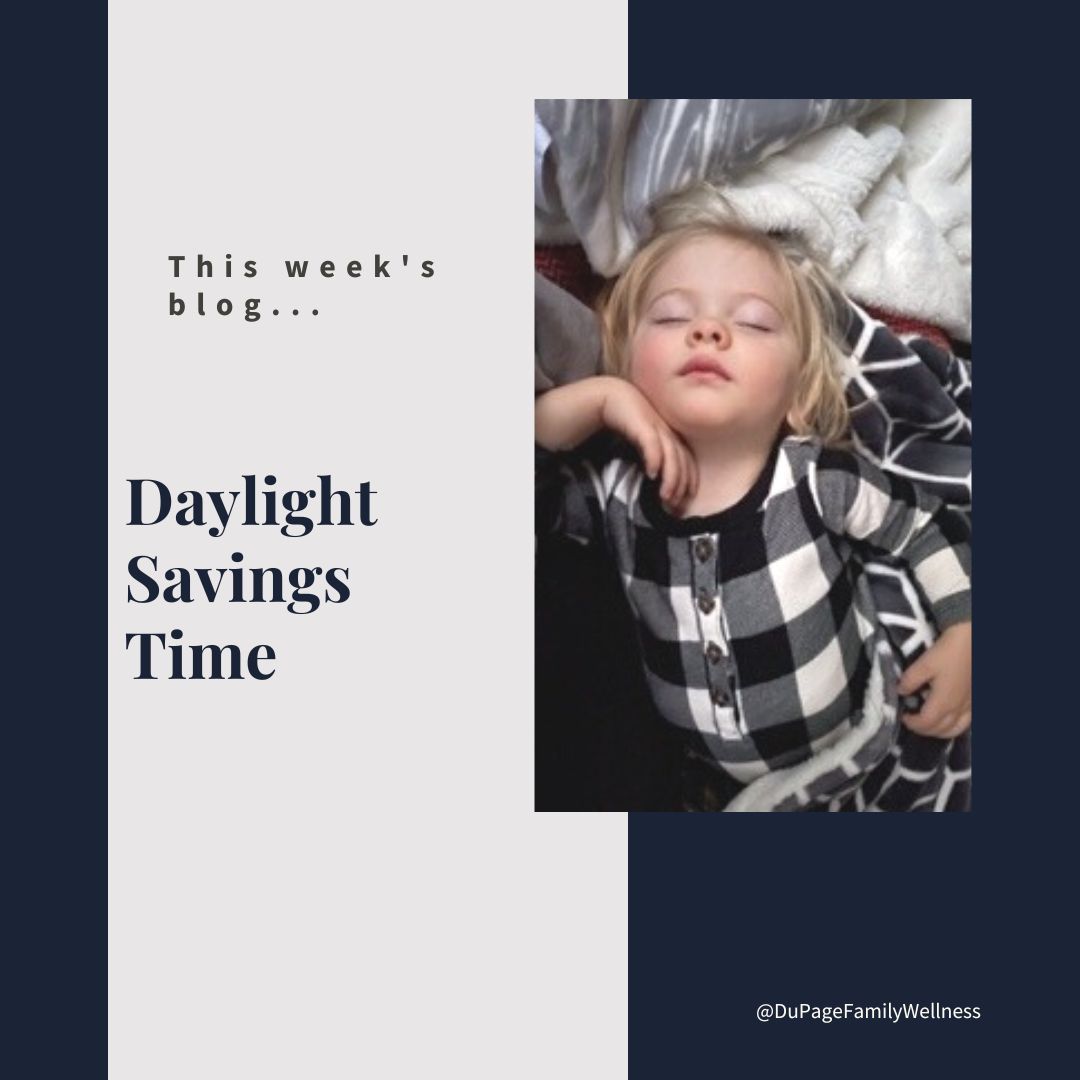 It can be tempting to reach for food when you are feeling the stress of the holidays, and with all the sweet treats around it is easier than ever to “stress eat!” Eating when you are stressed is considered emotional eating. It is an attempt to fill an emotional need rather than a physical one.
It can be tempting to reach for food when you are feeling the stress of the holidays, and with all the sweet treats around it is easier than ever to “stress eat!” Eating when you are stressed is considered emotional eating. It is an attempt to fill an emotional need rather than a physical one.
This strategy works temporarily as the treats distract you by the taste and affect the chemicals in your body. The surge of dopamine after a sweet treat brings temporary relief from the stress you are feeling, but it won’t last long.
While it may help you not to feel stressed in the moment, it doesn’t effectively deal with the underlying stressors and often leads to regret. There are many better ways to deal with stress, but first, you need to recognize when you are beginning to turn to food for relief.
Let’s take a look at emotional eating and how to handle it throughout the holiday season.
Building Awareness
Cultivating self-awareness is the first step to dealing with emotional eating. By checking in with yourself and knowing the clues, you can determine whether you are truly hungry or if you are trying to meet an emotional need.
When you go to eat, ask yourself, “How do I feel right now?”. Are you stressed, sad, lonely, angry, or bored? If you are experiencing a difficult emotion, ask yourself if you are really hungry or if you are trying to meet an emotional need.
Sometimes it can be hard to tell, but Mayo Clinic has identified some clues you can look for to determine if you are really hungry. For instance,
- physical hunger generally comes on gradually after a period of not eating, while emotional hunger can come on suddenly even if you have eaten recently.
- physical hunger is felt in the stomach, while emotional hunger is felt in the mind.
- physical hunger often builds gradually and there is patience felt in meeting that need, while emotional hunger tends to demand an immediate response.
- emotional hunger often feels like it can only be satisfied with a specific type of food, while physical hunger is able to be satisfied with a variety of options.
- emotional eating often makes you feel ashamed, while physical hunger just ends up leaving you satisfied.
Read more ...
 The holidays are a wonderful time of the year, but they can also be stressful. Many of us live at our capacity throughout the year. So, when we are expected to add extra responsibilities to our already too full plates it can feel overwhelming.
The holidays are a wonderful time of the year, but they can also be stressful. Many of us live at our capacity throughout the year. So, when we are expected to add extra responsibilities to our already too full plates it can feel overwhelming.
What can we do if we don’t want to let stress distract us from the joy of the holidays? Let’s start with self-care! I know many of you just groaned internally. Self-care may seem like one more thing on your to-do-list, but it doesn’t have to be difficult.
Finding simple ways to take care of yourself is a key component to getting through the holidays with as much joy as possible. It doesn’t have to take long, just a few minutes of intentional self-care can reset your system.
Let’s look at some ways to incorporate these practices into your holidays.
Grounding
Grounding is simply bringing your awareness back to the present moment by focusing on your body and surroundings. The key is the intention and awareness behind the action.
It can be as simple as
- closing your eyes and paying attention to your breath:
- looking at things in your surroundings one by one.
- noticing sensory input like a soft blanket or pillow.
For more directed grounding exercise check out the following:
Something enjoyable
Schedule something that you enjoy every day. It doesn’t have to take more than five minutes or cost anything at all. Seriously, it could be as simple as blowing bubbles in your milk. Just include one thing that you can look forward to.
Each person will be different based on personality, circumstance, and values. Think about what would be life-giving to you. Some ideas include:
- calling a friend
- giving yourself five minutes of solitude
- going for a quick run
- taking time to read.
It doesn’t matter what anyone else thinks, the important thing is to choose something that is enjoyable for you.
Read more ...
 Black Friday is over, but you still may be shopping for the next couple weeks. In our family, some of the most cherished gifts are things you can’t wrap under the tree. Most of us don’t need more material goods, so giving experiences can be a great way to express your love and make memories that last!
Black Friday is over, but you still may be shopping for the next couple weeks. In our family, some of the most cherished gifts are things you can’t wrap under the tree. Most of us don’t need more material goods, so giving experiences can be a great way to express your love and make memories that last!
One of my favorite gifts from my parents was a family membership to the Naperville Children's Museum for our family. Talk about a gift that keeps on giving! We thought of them every time we went there all year.
When you give an experience as a gift, the key is finding something they will enjoy that fits in your budget. It could be something super simple like a date with you to a local coffee shop, or it could be a little more elaborate.
Let’s look at some ideas for experiences that your loved ones may enjoy!
Children
Many children enjoy a new toy, but it can quickly get lost among all the others. That’s why experiences are so great. They will have the memory far longer than they will enjoy a toy. Think about getting them a…
- pass or membership to the Zoo (Brookfield and Cosley Zoo are both great)
- membership to a children's museum
- ticket to a new movie (with money for popcorn of course)
- ticket to take the Metra train (into the city or to Toot Toot’s restaurant in Glen Ellyn)
- kids' manicure/pedicure
- ticket to a children’s show (or school play)
- ticket to a sporting event
- couple of games of bowling
- horseback riding lesson
- series of swim lessons
Teenagers
Teens have outgrown most toys, but money feels so impersonal. A great solution is to give them an experience they would love! Consider giving the teens in your life a…
- ticket to a new movie (with money for snacks)
- manicure/pedicure
- ticket to a show at a local theater
- ticket to a sporting event
- Spotify credit
- craft class (pottery, macramé, etc.)
- horseback riding lesson
- music class
- escape room experience
Adults
Many of us have more things than we know what to do with. Organizing more things can be overwhelming. That’s why experiences are so valuable. Some ideas for adults are a…
- ticket to a sporting event
- manicure/pedicure
- foot, back, or full-body massage
- ticket to a show at a local theater
- Spotify credit
- store membership (Costo, etc.)
- escape room experience
- ax throwing experience
- coupon for watching their kids
Read more ...
 This time of year everyone is talking about gratitude. It’s great that we set time aside for it, but gratitude can be a healing practice all year round.
This time of year everyone is talking about gratitude. It’s great that we set time aside for it, but gratitude can be a healing practice all year round.
Research has found a practice of gratitude to be beneficial for your physical, psychological, and social well-being. Since it's free, does not take much time, and can be done in the privacy of your own home it may be worth developing.
A gratitude practice is different than having an "attitude of gratitude" or "looking on the bright side of things." For one thing, it is much more intentional than just being optimistic or thankful from time to time.
Let's explore the benefits of this practice and consider how to start one!
The Benefits of Gratitude
Feelings of gratitude are good for our brains, activating the hypothalamus and flooding our brains with the feel-good hormone dopamine. Some studies have found it decreased the prominent stress hormone cortisol and blood pressure while increasing heart rate variability.
Robert Emmons, the world’s leading scientific expert on gratitude, found that people who consistently practice gratitude report many physical, psychological, and social benefits such as:
Physical
- Stronger immune systems
- Less bothered by aches and pains
- Lower blood pressure
- Exercising more and take better care of their health
- Sleep longer and feel more refreshed upon waking
Psychological
- Higher levels of positive emotions
- More alert, alive, and awake
- More joy and pleasure
- More optimism and happiness
Social
- More helpful, generous, and compassionate
- More forgiving
- More outgoing
- Feel less lonely and isolated.
Brene Brown On Joy & Gratitude
Read more ...
 It’s that time of year again. Daylight savings time is ending, and we will be rolling the clocks back this weekend. Many people are glad that they will enjoy an extra hour in their evening, while others look forward to an extra hour of sleep.
It’s that time of year again. Daylight savings time is ending, and we will be rolling the clocks back this weekend. Many people are glad that they will enjoy an extra hour in their evening, while others look forward to an extra hour of sleep.
However, some people are not so excited about the change. For parents of little ones and those with a strong circadian rhythm, this change can be a challenge. Our bodies (and little ones) do not automatically align with the clock, especially when it is artificially changed.
If you are someone who struggles with the time change or your body simply needs to reset its circadian rhythm, there is one important piece of research-based advice I have for you. It has nothing to do with your evening and everything to do with your morning.
Let’s explore the most important thing you can do to get your sleep back on track.
Circadian Rhythm
According to the National Institute of General Medical Sciences (NIGMS), “Circadian rhythms are physical, mental, and behavioral changes that follow a 24-hour cycle. These natural processes respond primarily to light and dark and affect most living things, including animals, plants, and microbes.”
Simply speaking, it is the cycle your body goes through in 24 hours. This cycle is influenced by many things, but nothing affects it more than exposure to light and darkness. You may be thinking about light in the evening keeping you up; we all have heard to limit blue light before bed. This is an important aspect, but it’s not the most important.
You may be surprised to hear that morning sunlight is the most important factor in setting your circadian rhythm. Getting outside first thing in the morning can have a profound effect on your circadian rhythm, but it can be tricky in climates that don’t provide bright sunlight year-round.
How to Get Light
Some people are lucky to live in areas that get plenty of sunshine year-round. This isn’t true for everyone, but if you are one of the lucky ones take advantage of it. Go outside and let the sunshine on you.
In Chicago, the weather has been pretty nice lately, but soon we may have to bundle up to do this. Eventually, the sun will become less pronounced, and we may have to find other ways to get that bright light in the morning.
One way to do this is by using a light machine. It won’t give you all the health benefits, but it is a good alternative when necessary.
Read more ...
 Your metabolism is the process of your body converting what you eat and drink into energy. The energy produced is responsible for everything from your movement to the automatic functions of the body.
Your metabolism is the process of your body converting what you eat and drink into energy. The energy produced is responsible for everything from your movement to the automatic functions of the body.
The metabolism works around the clock continuing its job when you are sleeping. It is necessary that things such as your circulation, digestion, and breathing continue to work through the night. This all is dependent on your metabolism.
Have you ever wondered if your metabolism is low? If so, there are a couple of tests that you can do at home to get an objective perspective. The first involves some measures of your temperature. Another will involve your pulse.
Let’s look at these simple tests that may reveal some interesting information!
Cycles of Your Temperature
Typically, your temperature will be between 97.8 and 98.6 degrees. However, it ebbs and flows throughout your day.
- little lower in the morning
- peak mid-day
- decline again in the evening
If you are cycling, it will also vary based on the phase of the cycle you are in.
- from bleed to ovulation (follicular phase) it will be a little lower (maybe high 97s).
- during your luteal phase, it will be higher (98s).
How to Measure Your Temperature
To measure your basal body temperature, keep a thermometer by your bedside. Since your temperature fluctuates throughout the day, be sure to measure it when you first wake up in the morning.
When measuring your temperature be sure to take it under the tongue. Hold the thermometer in your mouth for 2-3 minutes to warm it up before pressing the button. These steps will help you get the most accurate reading and make sure you don't get artificially low temps.
Once you have done this for three days, take the average of your temperatures. An average below 97.8 can be a sign that your body has slowed your metabolism.
Measuring Your Temperature After Meals
Another clue in checking to see if your metabolism has slowed is taking your temperatures after you eat. Your temperature should go up slightly after meals because you are metabolizing that food. If it goes down after you eat it means your food increased your stress and your metabolism isn’t working well.
Again, it is important to take your temperature under your tongue. For the most accurate read, be sure to leave the thermometer in your mouth for a few minutes before turning it on.
Read more ...
 It can be tempting to reach for food when you are feeling the stress of the holidays, and with all the sweet treats around it is easier than ever to “stress eat!” Eating when you are stressed is considered emotional eating. It is an attempt to fill an emotional need rather than a physical one.
It can be tempting to reach for food when you are feeling the stress of the holidays, and with all the sweet treats around it is easier than ever to “stress eat!” Eating when you are stressed is considered emotional eating. It is an attempt to fill an emotional need rather than a physical one. 

 The holidays are a wonderful time of the year, but they can also be stressful. Many of us live at our capacity throughout the year. So, when we are expected to add extra responsibilities to our already too full plates it can feel overwhelming.
The holidays are a wonderful time of the year, but they can also be stressful. Many of us live at our capacity throughout the year. So, when we are expected to add extra responsibilities to our already too full plates it can feel overwhelming. Black Friday is over, but you still may be shopping for the next couple weeks. In our family, some of the most cherished gifts are things you can’t wrap under the tree. Most of us don’t need more material goods, so giving experiences can be a great way to express your love and make memories that last!
Black Friday is over, but you still may be shopping for the next couple weeks. In our family, some of the most cherished gifts are things you can’t wrap under the tree. Most of us don’t need more material goods, so giving experiences can be a great way to express your love and make memories that last!  This time of year everyone is talking about gratitude. It’s great that we set time aside for it, but gratitude can be a healing practice all year round.
This time of year everyone is talking about gratitude. It’s great that we set time aside for it, but gratitude can be a healing practice all year round. It’s that time of year again. Daylight savings time is ending, and we will be rolling the clocks back this weekend. Many people are glad that they will enjoy an extra hour in their evening, while others look forward to an extra hour of sleep.
It’s that time of year again. Daylight savings time is ending, and we will be rolling the clocks back this weekend. Many people are glad that they will enjoy an extra hour in their evening, while others look forward to an extra hour of sleep. Your metabolism is the process of your body converting what you eat and drink into energy. The energy produced is responsible for everything from your movement to the automatic functions of the body.
Your metabolism is the process of your body converting what you eat and drink into energy. The energy produced is responsible for everything from your movement to the automatic functions of the body.